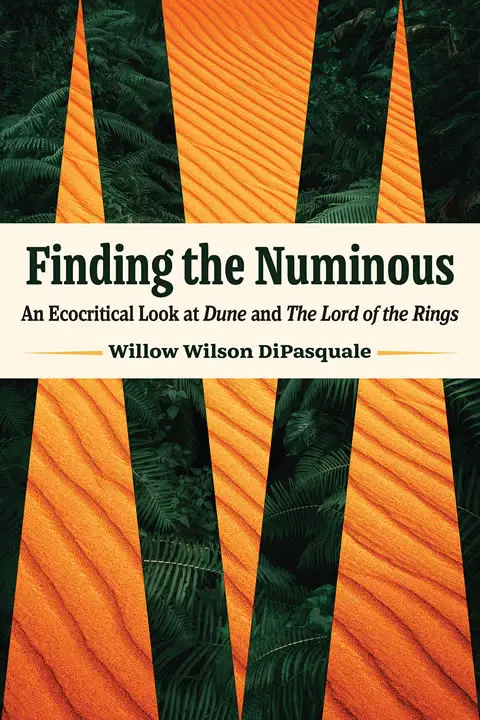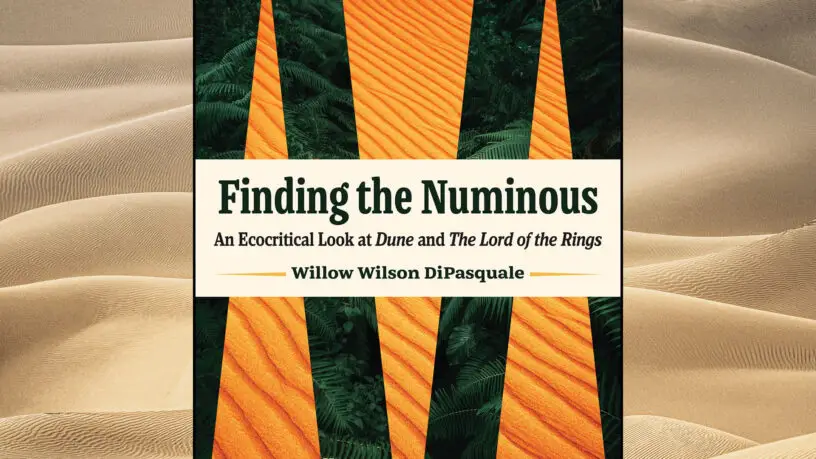In recent years, there appears to have been renewed interest from the academic community for Frank Herbert’s Dune. One such example being Discovering Dune which contained a series of essays exploring the Dune saga, including “Shifting Sands: Heroes, Power, and the Environment in the Dune Saga” by Willow Wilson DiPasquale. The author of that piece has returned to Arrakis for her latest book, which examines the roles the environment plays in the powerful myths created by Frank Herbert in Dune and J. R. R. Tolkien in the Lord of the Rings.

As this book also covers Lord of the Rings I was initially worried about whether I’d be able to follow along, as it has been several decades since I’d read those novels. For the most part, however, the characters, locations, and events will be understandable to anyone who has seen the Lord of the Rings movies, with Tom Bombadil being one obvious exception—although he will be familiar to those who have watched Amazon’s The Rings of Power TV show. Likewise, if you have only seen the movie adaptations of Dune there are potential spoilers, as the book draws on aspects from all six of Herbert’s Dune novels.
Each chapter leads us through an examination of a different aspect of the Duniverse and Legendarium (The Lord of the Rings novels), using examples from passages in the novels and building on previous academic work, to highlight how those novels’ themes and use of language reveal Herbert’s and Tolkien’s environmental messages and moral philosophies. I have found in the past that academic books can be heavy reading, but DiPasquale introduces concepts and terminology clearly as they arise, and I only had to refer to a dictionary a few times!
Chapter 1 starts with providing the definitions and principals used throughout the rest of the book. One key aspect is Tolkien’s classification the three functions of fantasy as recovery (gaining a new perspective), escape (reminding the reader of their longing for a better world), and consolation (renewing the feelings of hope, faith, and joy). This framework is used to show how the work of both Herbert and Tolkien reveal their messages about the environment and our responsibility to it.
Chapters 2 and 3 focus on the how the planets and places are described, how they function and characters’ interactions with their surroundings. To highlight the relationship of each community to the environment, key factions of Dune are divided into the categories of power with, power from, and power over the land. The Fremen have “power with” the land, working in harmony with the desert while at the opposite end of the spectrum the Harkonnen exert “power over” their environment through over industrialization.
… take the most special care that you locate Muad’Dib in his place: the planet Arrakis. Do not be deceived by the fact that he was born on Caladan and lived his first fifteen years there. Arrakis, the planet known as Dune, is forever his place.
from “Manual of Muad’Dib” by the Princess Irulan
Being immersed into these Secondary Worlds of the novels and observing how the actions of the characters impact their environment, from the Fremen living in harmony with the land to the Harkonnen’s exploitation and destruction of their world, the reader returns to the Primary (real) World with an greater appreciation of nature surrounding them, and how changes to their own lives could benefit the world.
Chapter 4 examines how usage of language within the sagas reinforce their themes, such as Atreides evoking the Greek Atreus family, or the interplay of plans within plans around the central environmental theme.
Then she said a good ruler has to learn his world’s language, that it’s different for every world. And I thought she meant they didn’t speak Galach on Arrakis, but she said that wasn’t it at all. She said she meant the language of the rocks and growing things, the language you don’t hear just with your ears. And I said that’s what Dr. Yueh calls the Mystery of Life.
Paul Atreides – Dune
Finally, chapter 5 looks at the personal lives and beliefs of both Tolkien and Herbert, and how their experiences can provide further insight into their works. This includes Herbert’s interest in Zen Buddhism, with its reverence for nature, and his friendship with members of the Coast Salish Indian tribe, who lived in balance with their land.
Being an academic publication, Finding the Numinous includes healthy Notes and Bibliography sections at the end, providing sources for the hundreds of references throughout the book, should you wish to continue your journey into this fascinating topic.
Officially releasing on February 25, 2025, the book is available now for $39.95 at major booksellers (online orders), including Amazon and Barnes & Noble. This is more expensive than many paperback releases, however the price does compare well to similar academic works, which can range up to over $100.
With each reading of Dune the reader can focus on different aspects; from the coming of age story, to the political or religious threads that are woven through the story. While the environmental readings are also obvious, Finding the Numinous provides a new lens through which to understand and appreciate Herbert’s works, and I look forward to applying that to my next reading of Dune – and has sparked an interest to return to the novels of Middle Earth too.

About the Author of Finding the Numinous
Willow Wilson DiPasquale is an instructor of English and writing at Bryn Mawr College, Arcadia University, and Thomas Jefferson University. She is the author of “Shifting Sands: Heroes, Power, and the Environment in the Dune Saga” in Discovering Dune: Essays on Frank Herbert’s Epic Saga. She received the 2024 Arcadia University Center for Teaching, Learning, and Mentoring’s Unsung Hero Award.
Note: Many thanks to Kent State University Press for providing the Dune News Net team with a review copy of this book.



